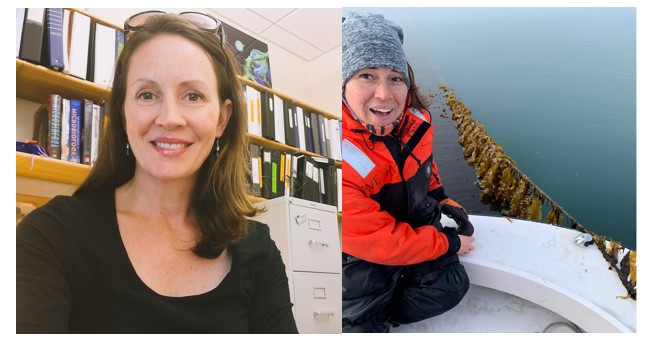
Seaweed harvested as a food product is a rapidly growing industry. The farming of a seaweed called sugar kelp has contributed over $130 million annually to the Maine economy and is rapidly growing. Because edible seaweed aquaculture is a relatively new industry in the US, there are no FDA regulations for bacterial monitoring that could impact the safety of seaweed as a food product. Similarly, there are no governmental guidelines for how seaweed should be stored, handled or processed prior to consumption, although these post-harvest conditions can have an impact on microbial load and thus product safety. Maine is a leader in seaweed culture and harvest for food consumption with no known cases of food-borne illness from consuming seaweed to date. However, as the seaweed industry continues to grow, it is important that we understand potential risk for such illness and provide guidance on how to minimize the risk.
In the Fall of 2019, a research team led by Dr. Carrie Byron (Assistant Professor, School of Marine Programs) and Dr. Kristin Burkholder (Associate Professor, Biology Department) published a study in the Journal of Applied Phycology (https://doi.org/10.1007/s10811-019-01993-5) in which they reported frequent, but low-level, detection of bacterial pathogens from sugar kelp farmed in the Gulf of Maine. These findings indicate that, similar to other seafood, seaweed is susceptible to contamination by pathogens present in water. Therefore, attention must be paid to post-harvest handling and processing conditions in order to minimize pathogen load and viability on the final product. Then in February 2020, Byron and Burkholder were awarded a $149,967, 2-year grant from the Maine Sea Grant Program for their proposal, titled, “Industry-established food safety guidelines for post-harvest handling of edible seaweed towards a more resilient coastal community”. This project follows on their preliminary work, and aims to examine how common post-harvest handling and processing conditions, such as the duration and temperature of fresh seaweed storage as well as the method used to dry seaweed prior to consumption, will impact pathogen load and viability.
Since the typical kelp growing season yields a March-May harvest, Byron and Burkholder planned to kick off the project during the Spring 2020 season. Burkholder recruited and began training a team of undergraduate researchers in her microbiology lab. Byron organized and convened a stakeholder meeting in early February, which hosted seaweed producers from across the state of Maine, along with researchers from the University of Maine and University of Connecticut. From the stakeholder meeting, the pair gained insight into strategies for maximizing the utility of their findings for Maine seaweed producers, and planned to hit the ground running when kelp became available later in the spring.
Soon after the stakeholder meeting, COVID cases began spreading across the US it became clear that their work would be halted due to canceled UNE boat operations, unavailability of student researchers and the need to quarantine with their families. So instead of hitting the ground running, the pair needed to pause. While frustrating, the pause allowed Byron and Burkholder the time to recruit a Master’s student, Jessica Vorse, a 2019 graduate of the College of Wooster in Ohio with research experience in crop microbiomes, who will join the project and the UNE School of Marine Programs August 2020. It’s also given Byron and Burkholder the chance to think flexibly and to consider how the project could be adapted to include different species of edible seaweed with different harvest seasons if needed, to accomplish their goals in this uncertain time.
Byron and Burkholder also work closely with Maine Sea Grant extension agent Jaclyn Robidoux, who notes that despite the pandemic, the Maine seaweed industry has done quite well in the 2020 season. The lead processor of kelp in Maine was able to honor all existing contracts with kelp farmers. A few small farmers pivoted and made private sales of fresh seaweed at $20/lb, compared to typical bulk sales of only a few dollars per pound, demonstrating that the seaweed industry is nimble and able to create new market niches as well as cater to evolving market demands. The success of the seaweed industry is a marked contrast to Maine shellfish and finfish harvesters struggling with lost revenue due to closed restaurants and lack of market demand. The strong performance by the seaweed industry also emphasizes the need for studies like the one proposed by Byron and Burkholder, which will provide science-based guidance for seaweed farmers and processors to ensure production of a safe food product with growing importance to the Maine economy.
